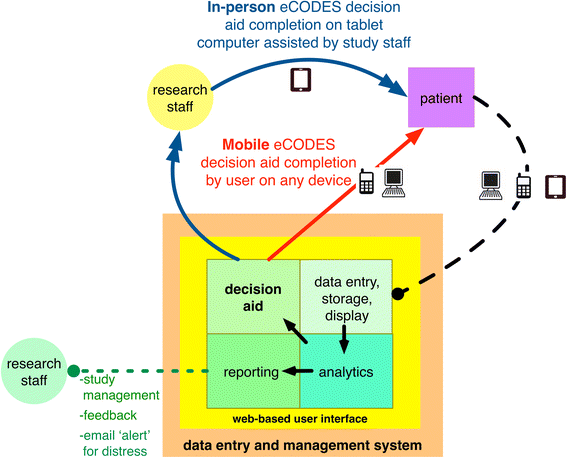Development and usability testing of a Web-based decision aid for families of patients receiving prolonged mechanical ventilation
- PMID: 25852965
- PMCID: PMC4385299
- DOI: 10.1186/s13613-015-0045-0
Development and usability testing of a Web-based decision aid for families of patients receiving prolonged mechanical ventilation
Abstract
Background: Web-based decision aids are increasingly important in medical research and clinical care. However, few have been studied in an intensive care unit setting. The objectives of this study were to develop a Web-based decision aid for family members of patients receiving prolonged mechanical ventilation and to evaluate its usability and acceptability.
Methods: Using an iterative process involving 48 critical illness survivors, family surrogate decision makers, and intensivists, we developed a Web-based decision aid addressing goals of care preferences for surrogate decision makers of patients with prolonged mechanical ventilation that could be either administered by study staff or completed independently by family members (Development Phase). After piloting the decision aid among 13 surrogate decision makers and seven intensivists, we assessed the decision aid's usability in the Evaluation Phase among a cohort of 30 surrogate decision makers using the Systems Usability Scale (SUS). Acceptability was assessed using measures of satisfaction and preference for electronic Collaborative Decision Support (eCODES) versus the original printed decision aid.
Results: The final decision aid, termed 'electronic Collaborative Decision Support', provides a framework for shared decision making, elicits relevant values and preferences, incorporates clinical data to personalize prognostic estimates generated from the ProVent prediction model, generates a printable document summarizing the user's interaction with the decision aid, and can digitally archive each user session. Usability was excellent (mean SUS, 80 ± 10) overall, but lower among those 56 years and older (73 ± 7) versus those who were younger (84 ± 9); p = 0.03. A total of 93% of users reported a preference for electronic versus printed versions.
Conclusions: The Web-based decision aid for ICU surrogate decision makers can facilitate highly individualized information sharing with excellent usability and acceptability. Decision aids that employ an electronic format such as eCODES represent a strategy that could enhance patient-clinician collaboration and decision making quality in intensive care.
Keywords: Chronic critical illness; Critical illness; Decision aid; Decision support; Patient reported outcomes; Patient-centeredness; Prolonged mechanical ventilation; Surrogate decision making; Usability.
Figures


References
-
- Sprung CL, Truog RD, Curtis JR, Joynt GM, Baras M, Michalsen A, et al. Seeking worldwide professional consensus on the principles of end-of-life care for the critically ill: the consensus for worldwide end-of-life practice for patients in intensive Care Units (WELPICUS) study. Am J Respir Crit Care Med. 2014;190:855–66. doi: 10.1164/rccm.201403-0593CC. - DOI - PubMed
Grants and funding
LinkOut - more resources
Full Text Sources
Other Literature Sources

